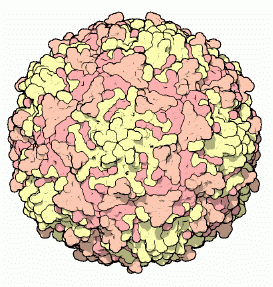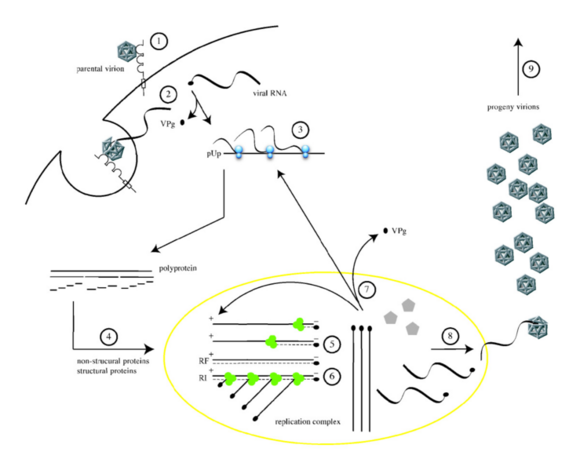Poliovirus
| Poliovirus | ||||||||
|---|---|---|---|---|---|---|---|---|
| Virus classification | ||||||||
|
Description and significance
Poliovirus is an enteroviruses which is a RNA virus that is stable and survive in acidic conditions. Poliovirus was first isolated by Karl Landersteiner and Erwin Popper in 1909. They proved that a virus caused the paralysis and not a bacterium. Karl Landsteiner presented that the cause of poliomyelitis could be experimentally transmitted to monkeys by injecting them with material that was made by grinding up the spinal cords of children who died from poliomyelitis.
Genome structure
Poliovirus is made up of a RNA genome and a protein capsid. The RNA genome is a linear, single-stranded, positive-strand RNA. It is about 7,500 nucleotides long. The viral component is about 300 Ångström wide with icosahdral symmetry. Poliovirus is composed of carbon, hydrogen, nitrogen, oxygen, phosphorus and sulphur. Poliovirus builds its RNA genes and its protective protein capsid from these elements. Poliovirus has three serotypes; PV1, PV2, and PV3. There are many strains of each serotype. The three serotypes are very infectious, but differ in the protein capsid. PV1 is the most common and harmful serotype. Poliovirus is commonly known as the most important and basic virus because of its short genome and simple structure.
Cell structure and metabolism
The cellular life cycle of poliovirus begins by binding of a poliovirion to the host cell surface receptor, CD155 (1). Destabilization of the virus capsid which is receptor dependent uncoats the viral RNA (2). Cellular phosphodiesterase cleaves the viral protein VPg and viral RNA is translated by a cap-independent (IRES-mediated) process (3). The viral polyprotein generates mature structural and non-structural proteins by proteolytic processing (4). The positive-sense RNA acts as template for complementary negative-strand synthesis, which constructs a double-stranded RNA (replicative form, RF) (5). Initiation of many positive strands from a single negative strand produces the partially single-stranded replicative intermediate (RI) (6). The synthesized positive-sense RNA molecules can act as templates for translation (7) or associate with capsid precursors to undergo encapsidation and the maturation cleavage of VP0 (8), which produces virions. The infected cell bursts and releases infectious viruses into the bloodstream(9). [1]
Ecology
Humans are the exclusive natural host for poliovirus. It cannot naturally infect other species. Monkeys and chimpanzees can be infected with poliovirus experimentally, but not naturally. Poliovirus is spread through sewage by infected people who pass their faeces. Even though an individual is immune to poliovirus, they can pass the virus through their faeces.
Pathology
Poliovirus causes the viral disease, poliomyelitis. Poliomyelitis is a very infectious disease. Humans are the exclusive natural host for poliovirus. It cannot naturally infect other species. There are two types of poliomyelitis; nonparalytic polio and paralytic polio. Nonparalytic polio is the main type of polio that doesn't lead to paralysis (abortive poliomyelitis). About 5-10% of people are affected by nonparalytic polio. About 1% of people are affected by paralytic polio. There are three types of paralytic poliomyelitis; spinal polio, bulbar polio, and bulbospinal polio.
Spinal polio is the most common paralytic polio. The poliovirus invades motor neurons in the spinal cord which may cause paralysis of the muscles that control breathing as well as the arms and legs.
Bulbar polio is the more severe case of poliomyelitis. The poliovirus attacks the motor neurons of the brain stem and causes difficulty in swallowing and speaking. Without respiratory support, bulbar polio can lead to death. In the 1940s and 50s, people infected with bulbar polio were treated with "iron lungs" - metal cylinders that were worked like a pair of bellows to regulate breathing. Today, the positive pressure ventilator replaced the iron lung.
Bulbospinal polio is a combination of bulbar and spinal polio. Bulbospinal polio can lead to paralysis of the arms and legs. It may also affect breathing, swallowing and heart function.
The poliovirus can take over the nervous system and can cause paralysis in hours. Poliovirus enters the body through the mouth and multiplies in the throat and intestine. Once the virus remains stable in the intestine, it can enter the blood stream and pass onto the central nervous system.
As poliovirus replicates, it damages motor neurons which affect the muscles for swallowing, circulation, respiration, as well as the trunk, arms, and legs. The damage of the motor neurons are irreparable and can cause acute flaccid paralysis (AFP) which affects the limbs. Paralysis of the trunk and muscles of the thorax and abdomen can result in quadriplegia.
In countries with poor sanitation, poliovirus can be spread to others by faeces of people who are infected by the virus. It can also infect vaccinated people; they will not develop polio, but they can carry this virus in their gastrointestinal tract and pass it on to others.
Symptoms of infected individuals include headache, fever, vomiting, stiffness and pain in the neck and back. Poliovirus can also lead to paralysis, usually in the legs. Some people infected with this virus do not have any symptoms so they do not know they have been infected.
Unfortunately, there is no known cure for poliomyelitis.
Current Research
Researchers Use Crippled Poliovirus to Attack Brain Cancer
In an experiment to attack brain cancer, Dr. Matthias Gromeier and researchers joined properties of poliovirus with an innocuous genetic coding element from the common cold. The new virus that resulted from the experiment showed a strong anti-cancer property that quickly killed cancer cell cultures and in animals. Even though the new virus contained cancer-killing properties of poliovirus, it did not cause polio. The altered poliovirus killed cancer cells from brain tumors as well as breast and colon cancer metastases within four to six hours. The researchers disabled poliovirus from killing normal brain cells while killing cancer cells in the brain. Researchers switched a genetic property from the common cold “rhinovirus” with a corresponding genetic property from poliovirus. The genetic element, called an internal ribosomal entry site ‘IRES,’ allows a virus to express its own genetic information inside the host cell it invaded. Poliovirus has a natural affinity to invade the brain. Poliovirus invades brain cells by binding to the CD155 receptor on the surface of motor neurons. Dr. Gromeier demonstrated that brain tumors over-produce the CD155 receptor, which makes the cell in the brain tumors more susceptible to poliovirus infection. The altered poliovirus enters the normal motor neurons because it shares the same CD155 receptor as brain tumor cells, but it can’t grow in normal neurons. Tests were done on mice and non-human primates and the results indicated that the altered poliovirus kills brain tumor cells, but it doesn’t damage normal motor neurons. The poliovirus would be injected into the brain tumor and it would find and destroy cancer cells without being detected by the body’s immune system. Dr. Gromeier stated, “Cell differ in terms of how well-suited they are to a particular virus. Every cell type has unique cellular proteins that can either support or block viral function, and we believe differences in these proteins account for the modified virus’ inability to infect normal brain cells.”
First Animal Model Developed for Oral Infection of Human Poliovirus
In the August 2007 issue of Journal of Virology, it was reported that researchers developed an animal model for oral poliovirus infection. Researchers were trying to find new ways to prevent the spread of the virus in countries with poor conditions. In the study, the mice that lacked the interferon receptor gene (IFNAR) and carried the human poliovirus receptor gene were affected by the oral ingestion of poliovirus. Nine days after the ingestion, the mice died and the poliovirus was found in their small intestines and digestive tracts. The mice that expressed the interferon receptor gene (IFNAR) were found to be less affected by the virus. These results show that the interferon receptor gene (IFNAR) is significant in determining how permissive the poliovirus is in the digestive tract as well as the production of virus-specific immune responses to the virus by the oral route. The researchers stated, “Thus, hPVR-Tg/IfnarKO are considered to be the first oral infection model for poliovirus.”
Researchers Use Poliovirus to Destroy Neuroblastoma in Mice
Researchers from Stony Brook University reported that a innocuous form of poliovirus can destroy neuroblastoma tumors in vaccinated mice. Poliovirus kills the host cell it infects so that it can make copies of itself. The researchers injected a weak strain of poliovirus into neuroblastoma tumors that have been transplanted into 12 mice. The poliovirus destroyed the neuroblastoma tumors in all the mice, but tumors reappeared in two mice at the end of the experimental period. The researchers also found out that the injection of poliovirus inhibited new tumor growth in mice. This was important because new growth is common in neuroblastoma even after chemotherapy.


